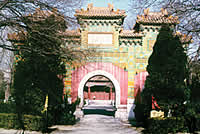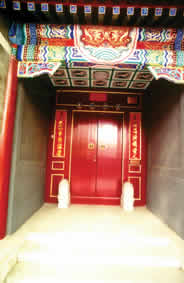| Guozijian - Beijing tranquil street of imperial study |
| http://www.sina.com.cn 2003/11/18 17:36 中国周刊 |
|
When asked which one of Beijing old streets is the most beautiful, I find the choice very difficult. Why? Simply because there are so many that are a sheer joy to walk through. After some thoughts I usually suggest that Guozijian Jie is one of the finest. Certainly from a historical perspective it is one of the most important in China. In historic times from this street emerged many of the laws and philosophical ideas that were fundamental to life in China of that time. It was also the training centre for the civil servants who put philosophy into practice. This street was the centre for Confucian Theory - theories that affected virtually every aspect of daily life. The street leads west from opposite the entrance to the magnificent Lama Temple (Yonghegong). Much of the main street, Yonghegong Dajie, has recently been transformed into a very pleasant environment for visitors and locals. The influence of the Temple extends into Guozijian Jie because the visitor is welcomed by slow herapeutic?Buddhist chants coming from shops at the street entrance. They are filled with artefacts from Tibet and Northwest China - tall incense sticks, tins of yak butter, bronze carvings of the Buddha, small shrines with imitation red candles, replicas of ancient coins hanging from long red strings, gongs, cymbals and hanka?cloths depicting various stages of Buddhist heavenly life from the訰oof of the World? The perfumed aroma of burning incense fills the air. Above the entrance to the street is an ornate arch with gold calligraphy on a blue background spelling out heng Xian Jie? Its red wooden legs are buried into square marble blocks with fading ornate carvings. Nearby a stone tablet tells the story of the area in Chinese.
Many original buildings have a common feature of being built above street level, as though on platforms. This facilitated ease of transfer from horses or coaches into the houses - so avoiding contact with mud or dirt from the days when the roads were not sealed surface. People are still living behind the walls. I looked into one open courtyard - a frame held climbing plants against a wall - small red flowers shoot from the green leaves. A man in blue clothes and cap from years gone by was moving boards of wood into place to close off his courtyard for the night. A delightful time for walking is early evening when the sun shining from a clear blue sky sets behind the streets many fine tall trees which provide welcome shade in summer. In winter they can be covered with snow - beautiful in a blue sky. Walking along this street during any national festival or holiday also reveals a blaze of red and yellow when every building raises the national flag.
The premier complex in the street is the Confucius Temple (Kongmiao) built during the Yuan dynasty (1206-1368). Adjacent to a colourful blue and gold painted arch its high walls are crimson and topped with green tiles, signifying its imperial importance. It is the second largest Confucius temple in China, second only to that at Qufu, Confucius?birthplace. Near the entrance a large marble stele, supported by four large upright stones, is inscribed in Chinese, Tibetan and Mongolian. Opposite stands an imposing screen wall also coloured crimson. There are many buildings of great importance. Through the ate of the First Teacher?(xianshimen) are courtyards shaded by pine trees. There stand 188 stone tablets bearing the names of scholars who passed the imperial examinations. North, beyond the ate of Great Achievements?(dachengmen) are eleven pavilions containing steles relating to Qing military expeditions. Two flights of stone stairs lead up to the Hall of Great Achievements containing a memorial tablet to Confucius. Between the stairs leading up to the hall is a marble plaque displaying two dragons playing with a pearl, while another dragon spews out mist. A light stone balustrade surrounds the hall while the roof is covered in glazed yellow tiles. Behind the central hall stands the Shrine of the Great Wise Man (chongshengci) erected to honour the ancestors of Confucius. Today part of the temple is the fascinating Capital Museum. A new museum is presently under construction in another part of the city.
Although built in 1287 it has been expanded many times, reaching its present size during the time of Emperor Qianlong (1736-96). After the founding of New China it was restored and became the library for Beijing. The Gate of Highest Learning (taixuemen) lies beyond the entrance. A glazed memorial arch stands there between a drum and bell tower. Beyond lies the premier attraction - the Jade Disk Hall (Biyong). Reached by marble bridges, it is a square pavilion in the centre of a round pool. A golden ball crowns its roof. This hall was where the emperor sometimes explained the works of classical writers to civil and military officials. In neighbouring exhibition rooms 189 stone tablets carry the text of 13 Chinese classics. This 18th work took 20 years to complete and contains 630,000 characters. As this was a building of slightly lesser importance than the Temple it exterior screen wall is grey brick with a grey tiled top although it still boasted ornate carved figures which acted as protectors against possible evil incursion. Passing through another fine archway, the street again is home for many ordinary people. Children in light autumn clothes having finished school for the day start to play in the street. The aroma and sounds of evening meals being prepared in the courtyards fills the air. Old men who have been sitting chatting all day start to head home, carrying bamboo birdcages. Lanes lead off to possibly fascinating hutongs and relics of Old Beijing hidden behind grey walls. One entrance with a semi-circular doorway and imitation carved windows has the appearance of once being a small temple. Meanwhile, keeping with tradition coal blocks are piled up outside and a woman pushing an old bamboo pram wanders past. The sound of saws suggests restoration work is in progress. However this area is protected and will be safe from real estate development. Some old buildings are undergoing renovation while newer structures, in keeping with local design, have been restricted to single-storey in height. Most have windows with red-painted surrounds and green inner frames. Newer courtyard homes are evident from their fine doors imitating those previously reserved for the high imperial officials - bright red with finely crafted bronze door knobs designed like lion heads. Some also have ornate marble dragons guarding the entrance. As a concession to modern life some now have garages large enough for two cars. A modern restaurant also constructed in the single-storey style of the hutong has a pair of fine marble lions standing outside. A neighbouring teahouse has many tiny earthen teacups decorating its windows. Where there is an open space, landscaping and environmental work has been undertaken to enhance the beauty of the area. From squares in the tidy grass large red flowers bloom above fine green fronds. Realising the street tourist potential, one shop now sells beautifully created miniature replicas of temples, siheyuans and copies of the historical arches. Nearby another sells fine musical instruments. The modern world of Beijing now appears - a shop displaying expensive motorcycles sits next door to one of the city spotlessly clean new toilets. An archway marks the end of the historical street. Pigeons with whistles attached continue to circle overhead while some white feathers gently float down over the archway. Ahead is Andingmennei Dajie, bustling with commercial activities and a world away from the imperial history of tranquil Guozijian Jie. |
| 【英语学习论坛】【评论】【大 中 小】【打印】【关闭】 |
 ◆Text and photos by BRUCE CONNOLLY
◆Text and photos by BRUCE CONNOLLY Soon the visitor comes upon some characteristic old buildings of Beijing. They are in the distinctive grey colour of the ordinary people for they date from a time when no ordinary mortal dared to have any other colour for fear of incurring the wrath of the emperor. Lines of sloping tiled roofs extend behind the walls. Traditionally they are composed of grey, curved interlocking tiles while house doors, recently painted maroon, are flush with the street. Colourful calligraphy dating from the Spring Festival still clings to the woodwork. Some have small wooden beams jutting out above their entrance. Several doorways are particularly fine and deeply recessed, indicating the status of their former residents. Circular or rectangular stone external piers sitting at ground level also signify their hierarchical position.
Soon the visitor comes upon some characteristic old buildings of Beijing. They are in the distinctive grey colour of the ordinary people for they date from a time when no ordinary mortal dared to have any other colour for fear of incurring the wrath of the emperor. Lines of sloping tiled roofs extend behind the walls. Traditionally they are composed of grey, curved interlocking tiles while house doors, recently painted maroon, are flush with the street. Colourful calligraphy dating from the Spring Festival still clings to the woodwork. Some have small wooden beams jutting out above their entrance. Several doorways are particularly fine and deeply recessed, indicating the status of their former residents. Circular or rectangular stone external piers sitting at ground level also signify their hierarchical position.  As I took in the peace birds were singing from their bamboo cage. Other birds, with whistles attached, circled overhead - thankfully there were few mechanical sounds to spoil the local peace and indeed beauty. Schoolgirls drifted past on cycles while another strolled along under a bamboo and paper umbrella characteristic of South West China. Meanwhile old men were passing the time playing chess or draughts. A cart loaded with domestic pottery bowls sat nearby.
As I took in the peace birds were singing from their bamboo cage. Other birds, with whistles attached, circled overhead - thankfully there were few mechanical sounds to spoil the local peace and indeed beauty. Schoolgirls drifted past on cycles while another strolled along under a bamboo and paper umbrella characteristic of South West China. Meanwhile old men were passing the time playing chess or draughts. A cart loaded with domestic pottery bowls sat nearby. Adjoining the Temple is the Imperial College and Library entered also through a wide entrance enclosing heavy wooden doors with four beams protruding and outlined in gold. Originally called aixue?in the Han Dynasty it was renamed uozijian?during the Tang Dynasty and gave its name to the street. It was the highest school in Old China, specialising in classical Chinese writing. Scholars who successfully completed the alace Examination? the highest civil service examination, received the title of inshi?or cholar?
Adjoining the Temple is the Imperial College and Library entered also through a wide entrance enclosing heavy wooden doors with four beams protruding and outlined in gold. Originally called aixue?in the Han Dynasty it was renamed uozijian?during the Tang Dynasty and gave its name to the street. It was the highest school in Old China, specialising in classical Chinese writing. Scholars who successfully completed the alace Examination? the highest civil service examination, received the title of inshi?or cholar?